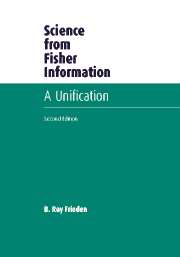Book contents
- Frontmatter
- Contents
- 0 Introduction
- 1 What is Fisher information?
- 2 Fisher information in a vector world
- 3 Extreme physical information
- 4 Derivation of relativistic quantum mechanics
- 5 Classical electrodynamics
- 6 The Einstein field equation of general relativity
- 7 Classical statistical physics
- 8 Power spectral 1 / ƒ noise
- 9 Physical constants and the 1/x probability law
- 10 Constrained-likelihood quantum measurement theory
- 11 Research topics
- 12 EPI and entangled realities: the EPR–Bohm experiment
- 13 Econophysics, with Raymond J. Hawkins
- 14 Growth and transport processes
- 15 Cancer growth, with Robert A. Gatenby
- 16 Summing up
- Appendix A Solutions common to entropy and Fisher I-extremization
- Appendix B Cramer–Rao inequalities for vector data
- Appendix C Cramer–Rao inequality for an imaginary parameter
- Appendix D EPI derivations of Schrödinger wave equation, Newtonian mechanics, and classical virial theorem
- Appendix E Factorization of the Klein–Gordon information
- Appendix F Evaluation of certain integrals
- Appendix G Schrödinger wave equation as a non-relativistic limit
- Appendix H Non-uniqueness of potential A for finite boundaries
- Appendix I Four-dimensional normalization
- Appendix J Transfer matrix method
- Appendix K Numerov method
- References
- Index
12 - EPI and entangled realities: the EPR–Bohm experiment
Published online by Cambridge University Press: 03 February 2010
- Frontmatter
- Contents
- 0 Introduction
- 1 What is Fisher information?
- 2 Fisher information in a vector world
- 3 Extreme physical information
- 4 Derivation of relativistic quantum mechanics
- 5 Classical electrodynamics
- 6 The Einstein field equation of general relativity
- 7 Classical statistical physics
- 8 Power spectral 1 / ƒ noise
- 9 Physical constants and the 1/x probability law
- 10 Constrained-likelihood quantum measurement theory
- 11 Research topics
- 12 EPI and entangled realities: the EPR–Bohm experiment
- 13 Econophysics, with Raymond J. Hawkins
- 14 Growth and transport processes
- 15 Cancer growth, with Robert A. Gatenby
- 16 Summing up
- Appendix A Solutions common to entropy and Fisher I-extremization
- Appendix B Cramer–Rao inequalities for vector data
- Appendix C Cramer–Rao inequality for an imaginary parameter
- Appendix D EPI derivations of Schrödinger wave equation, Newtonian mechanics, and classical virial theorem
- Appendix E Factorization of the Klein–Gordon information
- Appendix F Evaluation of certain integrals
- Appendix G Schrödinger wave equation as a non-relativistic limit
- Appendix H Non-uniqueness of potential A for finite boundaries
- Appendix I Four-dimensional normalization
- Appendix J Transfer matrix method
- Appendix K Numerov method
- References
- Index
Summary
Electron spin was derived by the use of EPI in Chapter 4, in the context of the Dirac equation. This was for the scenario of a single particle. Here, by comparison, we treat spin for a two-particle scenario, that of the well-known EPR–Bohm experiment. A general two-particle PDF can exhibit correlation. We show that the well-known probabilities of spin-pair combinations in the EPR–Bohm experiment follow simply from EPI; and that these do obey certain well-known correlation effects. See also a related derivation by S. Luo (2002).
Information J was previously regarded as the “bound” information (Chapter 3), in the sense of the amount of information that is bound to the unobserved source phenomenon. Here we find that it can also represent a degree of information entanglement between two particles: At the EPI solution, the information J for the observed particle equals the information I for the unobserved one. Or, the source of information for the observed particle is the unobserved one.
A final point of interest will be the use, in Sec. 12.4, of the game corollary |I| = min. (Eq. (3.21)) to determine a vital free parameter of the problem. This approach is also used in Chapter 4 to establish the appropriate number N of amplitude functions to describe various quantum particles, and in Chapter 15 to determine the unknown exponent of a power law for cancer growth. All parameters in the preceding are unitless, as is required for the use of Eq. (3.21). See further discussion in Sec. 12.10.
- Type
- Chapter
- Information
- Science from Fisher InformationA Unification, pp. 314 - 332Publisher: Cambridge University PressPrint publication year: 2004



